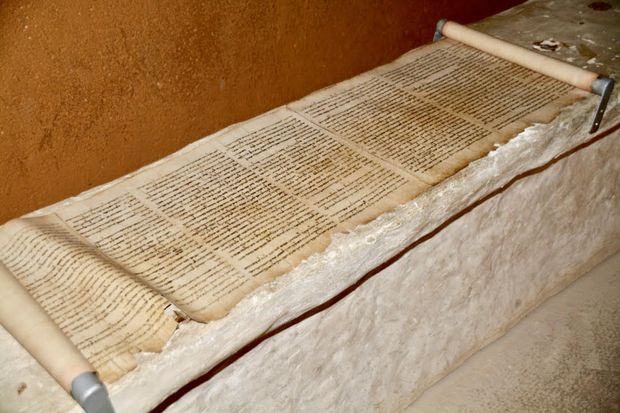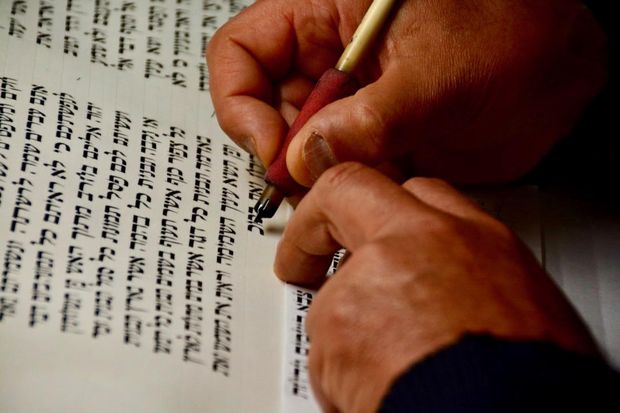The Egyptians used papyrus to make not only boats, but also baskets, footwear, utensils, a range of household objects, and, most importantly, the stems were used to make the famous material on which they wrote and drew pictures.
 Photo: Antonio Cruz
Photo: Antonio Cruz
“Can papyrus grow where there is no marsh?
Can reeds flourish where there is no water? (Job 8:11)
The Hebrew word gome, which is the word used in the Bible, refers to a “reed” or “papyrus”. It was translated into Greek as pápyros, and into Latin as papyrus.
It is a plant which grows in wetlands and marshes, of the Cyperus species (which means “reed”), a member of the ciperaceae family. It has a triangular section stem with a plume of filiform leaves arranged in a star-like fashion.

[photo_footer] Photo: Antonio Cruz. [/photo_footer]
The specific name “papyrus” means “made of paper”.
It is a plant which originated in the Mediterranean basin, and was abundant in Egypt, on the banks of the Nile, and especially in the Nile Delta.
Its historical and commercial importance was due to the fact that the stems were used to make papyrus manuscripts. Unfortunately, the plant is much less plentiful now because, as it obstructed riverways and irrigation canals, it has tended to be uprooted.

[photo_footer] Photo: Antonio Cruz. [/photo_footer]
Originally these reeds formed extensive bushes reaching lengths of up to five metres hand heights of six metres. This kind of density could only be crossed by large animals like hippopotami or elephants. The plant, jade-green in colour, thrives naturally, as its roots are immersed in water and can withstand temperatures of 20 to 33 degrees centigrade.
In biochemical terms, its photosynthesising process is very curious, as it can develop carbohydrates by the much more efficient means of four carbons (C4), also known as Hatch-Stack, in honour of its discoverers. There are six known different species of papyrus (Cyperus papyrus).
The Bible refers to papyrus as the material used for the basket, sealed with tar and bitumen, in which the baby Moses was placed (Exodus 2:3). Some translations opt for the term “reeds” instead of papyrus, but these reeds were, in fact, papyrus stems.
The book of Job also associates papyrus with flooded swamps (Job 8:11) and points out that the plant was used to make fast, light boats (Job 9:26).
Likewise, the prophet Isaiah says that these papyrus boats were abundant on the Nile (Isaiah 18:2). However, papyrus did not only grow in Egypt, but was also plentiful on the shores of the Sea of Galilee, on the plains of Sharon, on lake Hula or the waters of Merom (Joshua 11:5,7).

[photo_footer] Photo: Antonio Cruz. [/photo_footer] The Egyptians used papyrus to make not only boats, but also baskets, footwear, utensils, a range of household objects, and, most importantly, the stems were used to make the famous material on which they wrote and drew pictures. The cellulous fibres extracted from papyrus stems served, after being dried and stretched as required, to make rolls of a range of different sizes. The famous “Harris papyrus”, conserved in the British Museum, is the longest to have been found so far, with a length of 43.61 metres. Papyrus rolls were a very valuable, which was exported and exchanged for other products not available in Egypt, such as cedar wood or copper.
In the 7th century BC papyrus was the main writing material in the ancient world, and, subsequently, the Romans built huge papyrus factories in Alexandria. The Greeks began to call papyrus rolls biblia, which is the word that we now use for the Scriptures as the books that it comprises were first written on papyrus rolls. However, with the appearance of parchment made from animal skins the use of papyrus began to decline.
Certain graphic symbols produced on papyrus could be removed by means of special fluids when spelling or other mistakes were made.

[photo_footer] Photo: Antonio Cruz. [/photo_footer]
However, the scribes, or copiers of the Hebrew Scriptures were so scrupulous in their work and so horrified by such mistakes that they refused to erase them. They counted not only the words, but also the letters, as Hebrew was written only with consonants until several centuries after Christ, and adding or omitting any letter could substantially change the meaning of the word.
Therefore, if they made a mistake with a single letter, they would reject the whole section of the role as unsuitable for the synagogue, and they would rewrite it. Every time they had to write the name of God (Elohim or Adonai) they were said to have meticulously cleaned their pen. Why did the scribes carry out this ritual? Because, in the course of doing their job as copiers and scribes, they were conscious of worshiping God. And, of course, it is not possible to worship God through blots and erasures.
Thus the 19th century Methodist theologian Adam Clarke, commenting on the psalmist’s words: “blot out my transgressions” (Psalm 51:1), wrote the following:
Blot out my transgressions. (hxm), mecheh, wipe out. There is reference here to an indictment: the Psalmist knows what it contains; he pleads guilty, but begs that the writing may be defaced; that a proper fluid may be applied to the parchment, to discharge the ink, that no record of it may ever appear against him: and this only the mercy, lovingkindness, and tender compassions, of the Lord can do. [1]
[1] Spurgeon, C. H. The Treasury of David

Las opiniones vertidas por nuestros colaboradores se realizan a nivel personal, pudiendo coincidir o no con la postura de la dirección de Protestante Digital.
Si quieres comentar o